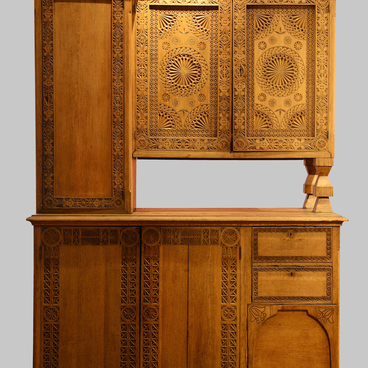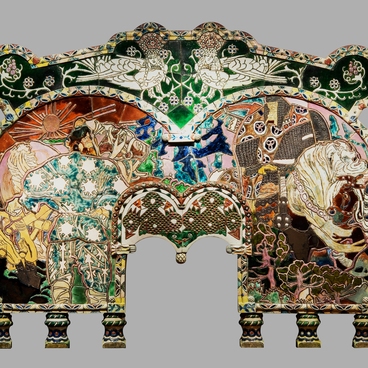Among the extensive expositions presented by the Russian Empire at the 1900 Paris Exhibition, the relatively small Pavilion of Russian handicrafts attracted special attention of the public. It was built based on the wooden architecture of the Russian North of the 17th century and looked like a fabulous “Old Russian” tower.
The pavilion was designed by artist Konstantin Korovin. The drawings and construction supervision were carried out by the architect Ilya Bondarenko. Alexander Golovin was responsible for the interior decoration. Painted wooden carvings that adorned the facades and interiors of the building were made by artisans of the toy workshop of the Moscow Provincial County in Sergiev Posad and the Abramtsevo carpentry workshop according to the designs of the pavilion authors.
The space allocated for the pavilion was very uncomfortable — a very narrow and long space along the Trocadero wall. But Konstantin Korovin coped with the task, placing four separate buildings on one axis and connecting them with open passageways-galleries. In the fall of 1899, the “rough” construction of the pavilion was completed in Moscow, then it was dismantled and transported to St. Petersburg to be sent to Paris by sea.
The final installation on site was carried out under the supervision of Ilya Bondarenko by Russian workers provided by Robert-Friedrich Meltzer, architect of the Russian (General) Department of the Paris Exhibition. At the same time, work was underway in Moscow and St. Petersburg to collect exhibits for the Pavilion. The task was to present the handicraft production of the Russian Empire in all its diversity, including the national outskirts.
The initial basis of the exposition was about two thousand items selected from the collection of the St. Petersburg Agricultural (later Handicraft) Museum. More than four thousand exhibits were received directly from artisans. The collection was organized by the Committee for the Organization of the Department and the Moscow Crafts Museum. The European public, more accustomed to factory products, was especially interested in handicraft samples.
Structurally, the pavilion’s exposition was divided into several groups according to the types of materials and included the Church and Historical sections. However, the task set by the organizers of the exhibition was not only to show handicrafts and works of peasant art. The main hall of the pavilion displayed works made in the workshops of Abramtsevo, Sergiev Posad, and the Moscow Crafts Museum.
The pavilion was designed by artist Konstantin Korovin. The drawings and construction supervision were carried out by the architect Ilya Bondarenko. Alexander Golovin was responsible for the interior decoration. Painted wooden carvings that adorned the facades and interiors of the building were made by artisans of the toy workshop of the Moscow Provincial County in Sergiev Posad and the Abramtsevo carpentry workshop according to the designs of the pavilion authors.
The space allocated for the pavilion was very uncomfortable — a very narrow and long space along the Trocadero wall. But Konstantin Korovin coped with the task, placing four separate buildings on one axis and connecting them with open passageways-galleries. In the fall of 1899, the “rough” construction of the pavilion was completed in Moscow, then it was dismantled and transported to St. Petersburg to be sent to Paris by sea.
The final installation on site was carried out under the supervision of Ilya Bondarenko by Russian workers provided by Robert-Friedrich Meltzer, architect of the Russian (General) Department of the Paris Exhibition. At the same time, work was underway in Moscow and St. Petersburg to collect exhibits for the Pavilion. The task was to present the handicraft production of the Russian Empire in all its diversity, including the national outskirts.
The initial basis of the exposition was about two thousand items selected from the collection of the St. Petersburg Agricultural (later Handicraft) Museum. More than four thousand exhibits were received directly from artisans. The collection was organized by the Committee for the Organization of the Department and the Moscow Crafts Museum. The European public, more accustomed to factory products, was especially interested in handicraft samples.
Structurally, the pavilion’s exposition was divided into several groups according to the types of materials and included the Church and Historical sections. However, the task set by the organizers of the exhibition was not only to show handicrafts and works of peasant art. The main hall of the pavilion displayed works made in the workshops of Abramtsevo, Sergiev Posad, and the Moscow Crafts Museum.

